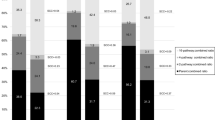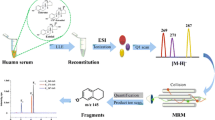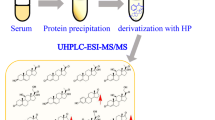Abstract
Estrogens and other endogenous steroids are known risk markers for cancer. Gas chromatography (GC) with mass spectrometry (MS) has traditionally predominated the analysis of estrogens and other endogenous steroids, but liquid chromatography (LC) MS is increasingly favored. Direct comparisons of the two technologies have hitherto not been performed. Steroids were analyzed from 232 urine samples of 78 premenopausal women in a blinded fashion by benchtop orbitrap LCMS and single quadrupole GCMS. Sixteen steroidal estrogens including oxidized metabolites could be analyzed by LCMS. LCMS–GCMS Spearman rank correlations of the major estrogens E1, E2, E3, 16α-OHE1, and 2-OHE1 were very high (r = 0.72–0.91), and absolute concentrations also agreed (<5% difference for E1, E2, E3, 16α-OHE1). LCMS allowed reinterrogation of the acquired data due to orbitrap technology, which permitted post-analysis quantitation of progesterone, cortisol, and cortisone (LCMS–GCMS Spearman rank correlations = 0.80–0.84; absolute difference, <7%; n = 137). GCMS allows the measurement of a wide range of steroids including non-polar analytes that escape the presented LCMS assay. In contrast, orbitrap-based LCMS can detect more estrogens, is faster, less costly, allows post-data acquisition reinterrogation of certain analytes that had not been targeted a priori, and requires much less urine.




Similar content being viewed by others
References
Xu X, Duncan AM, Merz BE, Kurzer MS (1998) Effects of soy isoflavones on estrogen and phytoestrogen metabolism in premenopausal women. Cancer Epidemiol Biomark Prev 7:1101–1108
Sepkovic DW, Bradlow HL (2009) Estrogen hydroxylation—the good and the bad. Ann N Y Acad Sci 1155:57–67
Rauh M (2009) Steroid measurement with LC-MS/MS in pediatric endocrinology. Mol Cell Endocrinol 301:272–281
Xu X, Veenstra TD, Fox SD, Roman JM, Issaq HJ, Falk R, Saavedra JE, Keefer LK, Ziegler RG (2005) Measuring fifteen endogenous estrogens simultaneously in human urine by high-performance liquid chromatography–mass spectrometry. Anal Chem 77:6646–6654
Faupel-Badger JM, Fuhrman BJ, Xu X, Falk RT, Keefer LK, Veenstra TD, Hoover RN, Ziegler RG (2010) Comparison of liquid chromatography–tandem mass spectrometry, RIA, and ELISA methods for measurement of urinary estrogens. Cancer Epidemiol Biomark Prev 19:292–300
Nelson RE, Grebe SK, OKane DJ, Singh RJ (2004) Liquid chromatography–tandem mass spectrometry assay for simultaneous measurement of estradiol and estrone in human plasma. Clin Chem 50:373–384
Setiawan VW, Monroe KR, Wilkens LR, Kolonel LN, Pike MC, Henderson BE (2009) Breast cancer risk factors defined by estrogen and progesterone receptor status: the multiethnic cohort study. Am J Epidemiol 169:1251–1259
Tworoger SS, Missmer SA, Eliassen AH, Spiegelman D, Folkerd E, Dowsett M, Barbieri RL, Hankinson SE (2006) The association of plasma DHEA and DHEA sulfate with breast cancer risk in predominantly premenopausal women. Cancer Epidemiol Biomark Prev 15:967–971
Key T, Appleby P, Barnes I, Reeves G, Endogenous H, Breast Cancer Collaborative G (2002) Endogenous sex hormones and breast cancer in postmenopausal women: reanalysis of nine prospective studies. J Natl Cancer Inst 94:606–616
Bradlow HL, Davis DL, Lin G, Sepkovic D, Tiwari R (1995) Effects of pesticides on the ratio of 16 alpha/2-hydroxyestrone: a biologic marker of breast cancer risk. Environ Health Perspect 103(Suppl 7):147–150
Nebert DW (1993) Elevated estrogen 16 alpha-hydroxylase activity: is this a genotoxic or nongenotoxic biomarker in human breast cancer risk? J Natl Cancer Inst 85:1888–1891
Yager JD, Liehr JG (1996) Molecular mechanisms of estrogen carcinogenesis. Annu Rev Pharmacol Toxicol 36:203–232
IARC (2007) Combined estrogen–progestogen contraceptives and combined estrogen–progestogen menopausal therapy. World Health Organization, Albany, NY, p 543
Nettleton JA, Greany KA, Thomas W, Wangen KE, Adlercreutz H, Kurzer MS (2005) The effect of soy consumption on the urinary 2:16-hydroxyestrone ratio in postmenopausal women depends on equol production status but is not influenced by probiotic consumption. J Nutr 135:603–608
Mense SM, Chhabra J, Bhat HK (2008) Preferential induction of cytochrome P450 1A1 over cytochrome P450 1B1 in human breast epithelial cells following exposure to quercetin. J Steroid Biochem Mol Biol 110:157–162
Eliassen AH, Ziegler RG, Rosner B, Veenstra TD, Roman JM, Xu X, Hankinson SE (2009) Reproducibility of fifteen urinary estrogens and estrogen metabolites over a 2- to 3-year period in premenopausal women. Cancer Epidemiol Biomark Prev 18:2860–2868
Maskarinec G, Morimoto Y, Conroy S, Pagano I, Franke A (2011) No changes in nipple aspirate fluid volume during a randomized soy trial. J Nutr 141:626–630
Falk RT, Xu X, Keefer L, Veenstra TD, Ziegler RG (2008) A liquid chromatography–mass spectrometry method for the simultaneous measurement of 15 urinary estrogens and estrogen metabolites: assay reproducibility and interindividual variability. Cancer Epidemiol Biomark Prev 17:3411–3418
Shackleton CH (1986) Profiling steroid hormones and urinary steroids. J Chromatogr 379:91–156
U.S. Department of Health and Human Services, Food and Drug Administration, Center for Drug Evaluation and Research, Center for Veterinary Medicine (2001) Guidance for industry: bioanalytical method validation
Franke AA, Halm BM, Kakazu K, Li X (2009) Metabolism, Bioavailability, and analysis of dietary isoflavones. In: Fraga C (ed) Plant phenolics and human health: biochemistry, nutrition, and pharmacology. The Wiley-IUBMB Series on Biochemistry and Molecular Biology. Wiley, New York
Franke A, Halm B, Ashburn L (2008) Isoflavones in children and adults consuming soy. Arch Biochem Biophys 476:161–170
Bartzatt R (2001) Dansylation of hydroxyl and carboxylic acid functional groups. J Biochem Biophys Methods 47:189–195
Setchell KD, Zhao X, Jha P, Heubi JE, Brown NM (2009) The pharmacokinetic behavior of the soy isoflavone metabolite S-(−)equol and its diastereoisomer R-(+)equol in healthy adults determined by using stable-isotope-labeled tracers. Am J Clin Nutr 90:1029–1037
Shu XO, Zheng Y, Cai H, Gu K, Chen Z, Zheng W, Lu W (2009) Soy food intake and breast cancer survival. JAMA 302:2437–2443
Dai Q, Franke AA, Jin F, Shu X-O, Hebert JR, Custer LJ, Cheng J, Gao Y-T, Zheng W (2002) Urinary excretion of phytoestrogens and risk of breast cancer among Chinese women in Shanghai. Cancer Epidemiol Biomark Prev 11:815–821
Goodman MT, Shvetsov YB, Wilkens LR, Franke AA, Le Marchand L, Kakazu KK, Nomura AM, Henderson BE, Kolonel LN (2009) Urinary phytoestrogen excretion and postmenopausal breast cancer risk: the multiethnic cohort study. Cancer Prev Res (Phila Pa) 2:887–894
Korde LA, Wu AH, Fears T, Nomura AM, West DW, Kolonel LN, Pike MC, Hoover RN, Ziegler RG (2009) Childhood soy intake and breast cancer risk in Asian American women. Cancer Epidemiol Biomark Prev 18:1050–1059
Wu AH, Wan P, Hankin J, Tseng CC, Yu MC, Pike MC (2002) Adolescent and adult soy intake and risk of breast cancer in Asian-Americans. Carcinogenesis 23:1491–1496
Shu XO, Jin F, Dai Q, Wen W, Potter JD, Kushi LH, Ruan Z, Gao YT, Zheng W (2001) Soyfood intake during adolescence and subsequent risk of breast cancer among Chinese women. Cancer Epidemiol Biomark Prev 10:483–488
Franke AA, Halm BM, Kakazu K, Li X, Custer L (2009) Phytoestrogenic isoflavonoids in epidemiologic and clinical research. Drug Testing and Analysis 1:14–21
Soldin SJ, Soldin OP (2009) Steroid hormone analysis by tandem mass spectrometry. Clin Chem 55:1061–1066
Blonder J, Johann DJ, Veenstra TD, Xiao Z, Emmert-Buck MR, Ziegler RG, Rodriguez-Canales J, Hanson JA, Xu X (2008) Quantitation of steroid hormones in thin fresh frozen tissue sections. Anal Chem 80:8845–8852
Courant F, Aksglaede L, Antignac JP, Monteau F, Sorensen K, Andersson AM, Skakkebaek NE, Juul A, Bizec BL (2010) Assessment of circulating sex steroid levels in prepubertal and pubertal boys and girls by a novel ultrasensitive gas chromatography–tandem mass spectrometry method. J Clin Endocrinol Metab 95:82–92
Acknowledgments
We thank Jennifer F. Lai (University of Hawaii Cancer Center) for the skillful assistance with manuscript preparations. Support for this study was obtained by grants from the National Cancer Institute R01 CA 80843 and P30 CA71789 and from the National Center for Research Resources S10 RR020890.
Author information
Authors and Affiliations
Corresponding author
Rights and permissions
About this article
Cite this article
Franke, A.A., Custer, L.J., Morimoto, Y. et al. Analysis of urinary estrogens, their oxidized metabolites, and other endogenous steroids by benchtop orbitrap LCMS versus traditional quadrupole GCMS. Anal Bioanal Chem 401, 1319–1330 (2011). https://doi.org/10.1007/s00216-011-5164-3
Received:
Revised:
Accepted:
Published:
Issue Date:
DOI: https://doi.org/10.1007/s00216-011-5164-3




